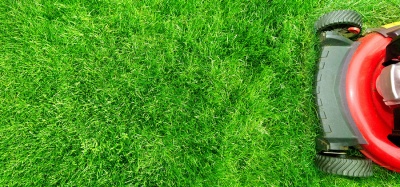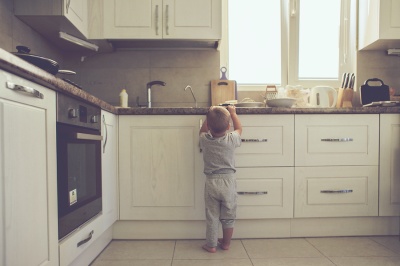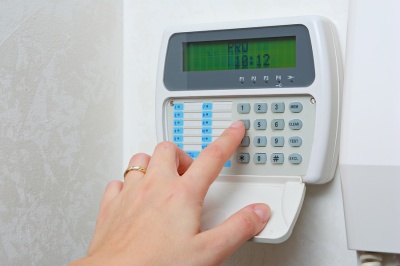
Spring is right around the corner, which makes it the perfect time to do some cleaning. Sometimes it can get overwhelming and you don’t know where to start. Make your home fresh for spring by cleaning, de-cluttering, and updating the rooms of your home.
Clean your home
Giving your home a thorough cleaning in the spring is a must for getting rid of the accumulated dirt and grime that builds up over winter. This is the perfect time to do all of those things you said you would get around to cleaning and haven’t done yet.
- Garbage cans – Hose down any plastic garbage cans and leave them outside and upside down to dry. Sprinkle the bottom of the cans with baking soda to keep them odor free.
- Floors– Gather up your throw rugs and shake them out outside. Clean your doormats, carpets, and the other floors in your home really well.
- Clean out the fridge – Throw out any expired food, open bottles of condiments from last summer, etc. Wipe down all of the shelves before placing food back on the shelves.
- Remove dust – from ceiling fans, vents, and light fixtures. Also be sure to wipe down walls, cabinets, baseboards, and woodwork. Use a sponge mop to get hard to reach areas.
- Clean all windows and mirrors – Any mirrors or windows in your home, make sure to spray some Windex on them and get rid of any streaks.
De-clutter your home
While cleaning helps with a lot of the dust and grime, it could be a good idea to start de-cluttering your home and downsizing.
- Go through your closet and donate (or sell) clothes that not longer fit you or you no longer like to wear.
- Keep just the essentials by your bed and store the rest away. For your essentials – have a pamper basket next to your bed that contains a book, some moisturizer, and anything else that you like to do in bed. The only other things besides your pamper basket should be a clock, lamp, and a box of tissues.
- Throw away any products in your bathroom that are half used and you know you won’t use again (even though you tell yourself you will.) This includes old makeup, half empty shampoo bottle, and old creams.
Update your home
While you are downsizing and cleaning, the final thing you can do to make your home truly feel great and fresh would be to update some of your belongings!
- Buy yourself new sheets. Something soft that will make you feel good in the new season. While you’re at it, update your pillows, blankets, and anything else you can think of in your bedroom.
- Just because it says update, doesn’t mean that it’s expensive! Try rearranging your furniture to give an updated look to the rooms in your home.
- Change the scent! Stray from the heavy winter scents and go for candles and air fresheners that make you feel like spring is here to say – cotton and flower scents are good choices.
Cleaning, de-cluttering and updating your home will make you feel great going into this spring.

Winter is brutal to your lawn. When spring comes around, your lawn can be left looking dull with dead patches sporadically appearing throughout your yard. The most important part of making your lawn look fresh and green is by working on the soil beneath the grass. After the last snow falls for the year, it’s time to clean up your yard and make it presentable for the spring season!
The first step to making your lawn look “revived” is cleaning it up! Take the opportunity on a nice day and go out into your yard and clear away any debris that covers the grass. You can use a rake or a blower to get the job done. Any plants, shrubs, or trees that did not survive the winter need to be removed. If there are any parts of the plant or tree that still living, you don’t have to remove the entire thing – just the dead area. By pruning and trimming it back, it not only makes your yard look nicer, it also makes gives the plants an area to grow.
The next step is working with that soil. As previously mentioned, the soil beneath the grass is giving it all of the nutrients! If the soil underneath isn’t healthy and being well maintained, you grass and plants won’t be well maintained either. After a long winter with a lot of snow, your lawn was likely patted down, which can make it difficult for the soil to get the nutrients it needs. Aerate your lawn by poking holes in it or use an aerator. If you don’t know how to do it properly, it’s best to hire a professional. For those dead patches in your yard, you need to make a decision of whether you want to grow new grass that will take some time or use sod grass over the patches. Nutrients are so important for your soil and it’s important add them to your lawn to encourage healthy growing.
Weeds aren’t fun to deal with, but if you want your lawn to look great, you need to take care of the weeds in your yard. Early in the season, pull out any weeds that you see and take preventative measures by using herbicide. Be sure to do this before watering or applying any fertilizers that would likely encourage weed growth.
The most important part of making your lawn look great after a long winter is maintenance. It’s important to mow at regular intervals, fertilize it periodically, and take care of other duties such as pulling weeds as they appear. If you have trouble keeping up with your lawn, calling a professional can help you with the maintenance and could be well worth the investment for a great looking property.

Are you ready to bring home your new bundle of joy? Homes are dangerous to babies and young children. Children are constantly learning and are curious about the environment around them, but this can get them into some unintentional trouble. According to the U.S. Centers for Disease Control and Prevention, about 9 million children (ages 0-19) are seen in emergency departments for injuries and more than 9,000 children die as a result of being injured. Childproofing is a necessary step for preventing accidental injury or death to a little one in your home.
Be Aware of Falling Furniture
You know well enough as an adult not to hang or climb on heavy furniture, but your children do not. Especially if the furniture is unbalanced, it is a danger to your child. Anchor heavy furniture such as dressers, entertainment centers, bookcases, etc. to the wall using anti tip, earthquake proof straps. You also need to be aware of anything that is on top of desk that can potentially fall and injure your child. Televisions, lamps, and heavy books can easily be pushed or tugged off a table accidentally.
Utilize Locks and Height
Using childproof cabinet locks, be sure to lock up toxic cleaning products, sharp implements, and any medicine (your child might think its candy.) . For products, if you do not wish to purchase good locks (getting a pack of 7 for $3 are likely to break quickly. You should invest in good quality products), you should put them in a high location where children are unable to reach them. Toilets and any other places with water should be locked or children should be supervised. Children can drown in very little water.
Pay Attention to Potential Choking Hazards
Children tend to put things in their mouth and anything that can fit through a cardboard toilet paper roll is too small and can potentially be a choking hazard. This includes items such as removable caps, small pieces of toys, dice, plastic insets placed in unused electrical sockets, etc.
Use Gates When Appropriate
Gates can be used when you don’t want your child to have access to a certain area. Use a gate at the top or bottom of stairs if you don’t want them to accidentally fall down the stairs; use a fate at their bedroom door at night to prevent older toddlers and children from wandering around. If you have a pool, make sure to use good quality pool fencing to limit your child from accessing the pool area unattended.
Careful with Electricity and Cords
Electricity and shock is very dangerous to anyone, especially young children. Cover electrical outlets with sliding covers instead of plastic inserts (which can be pulled out and present a choking hazard.) Tuck exposed cords behind molding or use a tubing system, which will help prevent kids from chewing on them. Be sure to unplug hair dryers, straightening irons, etc. and put them on a high shelf.

Whether you are moving to a new town in your state, or heading to a city hundreds of miles away, it can be overwhelming if you don’t know the area and don’t have friends and family in the location. Follow the tips below for getting settled and more acclimated in your new home town.
Find the local shops.
Drive around and find the nearest grocery store, CVS or Walgreens, coffee shop, movie theater, gym, etc. It’s always helpful to find them before you actually have a need to go.
Map your route to work.
Before your first day of work, make sure to map out your route and take a drive by to see exactly how long it would take you to get there. If possible, try going on a weekday, so you can see if you would be stuck behind busses or if there is a lot of traffic on a particular route.
Use your current connections.
Making friends in your new location is essential for social interaction and your overall happiness. Before you move, ask your current friends and connections if they know anybody who lives in the place you are moving to. These people can be your first friends or at the very least, a good person to ask about things going on in town.
Introduce yourself to your new neighbors.
When you move into your new home, it’s best to get to know the locals in your neighborhood. They might not make the first move, as they don’t want to disturb you while you’re moving and trying to settle in. It’s up to you to say hello and wave when you see them outside and perhaps you can form a good relationship with them over time. Going for walks around your neighborhood can also expose you to more people.
Join organized groups.
Another way to get active in your new neighborhood and make friends would be to join organized groups for your hobbies. This can be a group fitness class at the gym that you join, something you find on a bulletin board at a coffee shop, a work related group, or even something you find online with the help of meetup.com or couchsurfing.
Be active in your children’s schools.
If you have young children in school, be sure to be active if possible. Go to PTA meetings, watch your kids in the school play, volunteer as a chaperone, etc. This will not only help your kids feel more comfortable in a new school system, this can also help you become more familiar with your kid’s teachers and friends.
Always say yes when invited.
Until you make a group of friends in your new location, you should always say yes whenever you are invited out somewhere. Even if the activity isn’t something that you’ve done before or something that you’re particularly that interested in, you may make some new friends by participating and maybe even get a good experience out of it too.

Your home should be a place where you and your family should feel safe. Burglars threaten that security, but there are things you can do to make sure that your home and family aren't being targeted. Check out these 13 tips below to help keep your home from being targeted by home intruders.
Always Make It Seem Like Someone Is Home
Whether you are on vacation for a week or simply going to the store and running errands for a few hours, you always want to make sure it seems like somebody is home, even if the house is empty. There are a few ways that you can portray this.
- Never let flyers, menus, and newspapers sit out. Always make sure to collect them or if you are on vacation, have a trusted neighbor come by and pick these ups each day.
- Pretend like you’re saying goodbye to someone when you’re leaving your home. This only works if you are visible (your car isn’t in a garage) but can fool someone that is watching you into thinking someone is still home.
- If you’re on vacation and it snows, have your neighbors make tracks in the snow. Untouched snow is an obvious tip for burglars to see nobody is home.
Think About Outside
The way you landscape your home or keep your yard can make you a target for someone that wants to break into your home.
- Always make sure that your landscaping is neat. Be aware of any places that burglars and intruders can lurk and hide. This means keeping bushes and shrubs away from any first floor windows.
- Don’t ever leave a ladder in your backyard. This makes it easier for burglars to reach an upstairs window that you may not have locked.
- Mow your lawn. If you’re on vacation and your lawn starts to grow out, this is an easy cue for someone to know you haven’t been around in a while. Have a friend or neighbor do it if you’ll be out of town for a long period of time.
Have Extra Security
Installing a home security system is a great idea; however, it can become a little costly. There are other things that you can do to intimidate them and stop them from targeting your home.
- Buy light timers for indoor and outdoor lights (be sure to use fluorescent bulbs to keep energy costs down.) Have them go on night, before you get home. This will make it seem like someone is home and provides you some safety when entering your home.
- Buy some fake alarm system decals. Do this if you can’t afford or wouldn’t like to purchase an actual home security system. You can also purchase “beware of dog” signs. These signs may make a potential intruder choose what they think is an easier target instead.
- Reinforce door jams by installing long screws (4 inch) to replace the small screws that are most likely installed. This will make it harder for a burglar to kick the door in and the extra noise may prevent them from continuing on.
- For sliding doors or windows, use a wooden dowel or metal bar that fits into its track when it’s closed. This will prevent it from being pried open.
Other Tips
- Don’t leave electronics boxes on the curb. Instead, cut them up and conceal them in recycling bins. Having proof of your electronics on your curb will make you a target.
- Don’t leave status updates about being on vacation until AFTER you’re back from your trip. Posting them while on your trip alerts everyone that you’re not home and won’t be for a while.
- Have the post office hold your mail until you get back from vacation.


